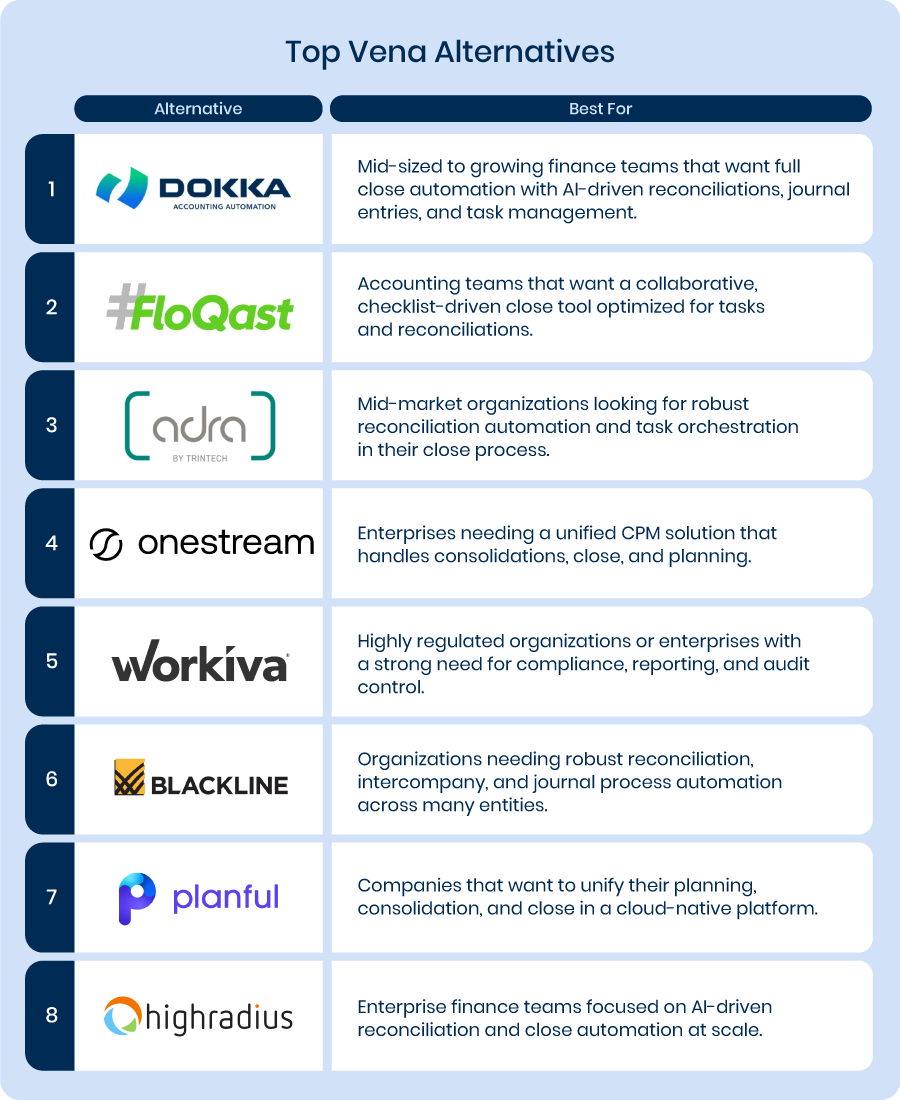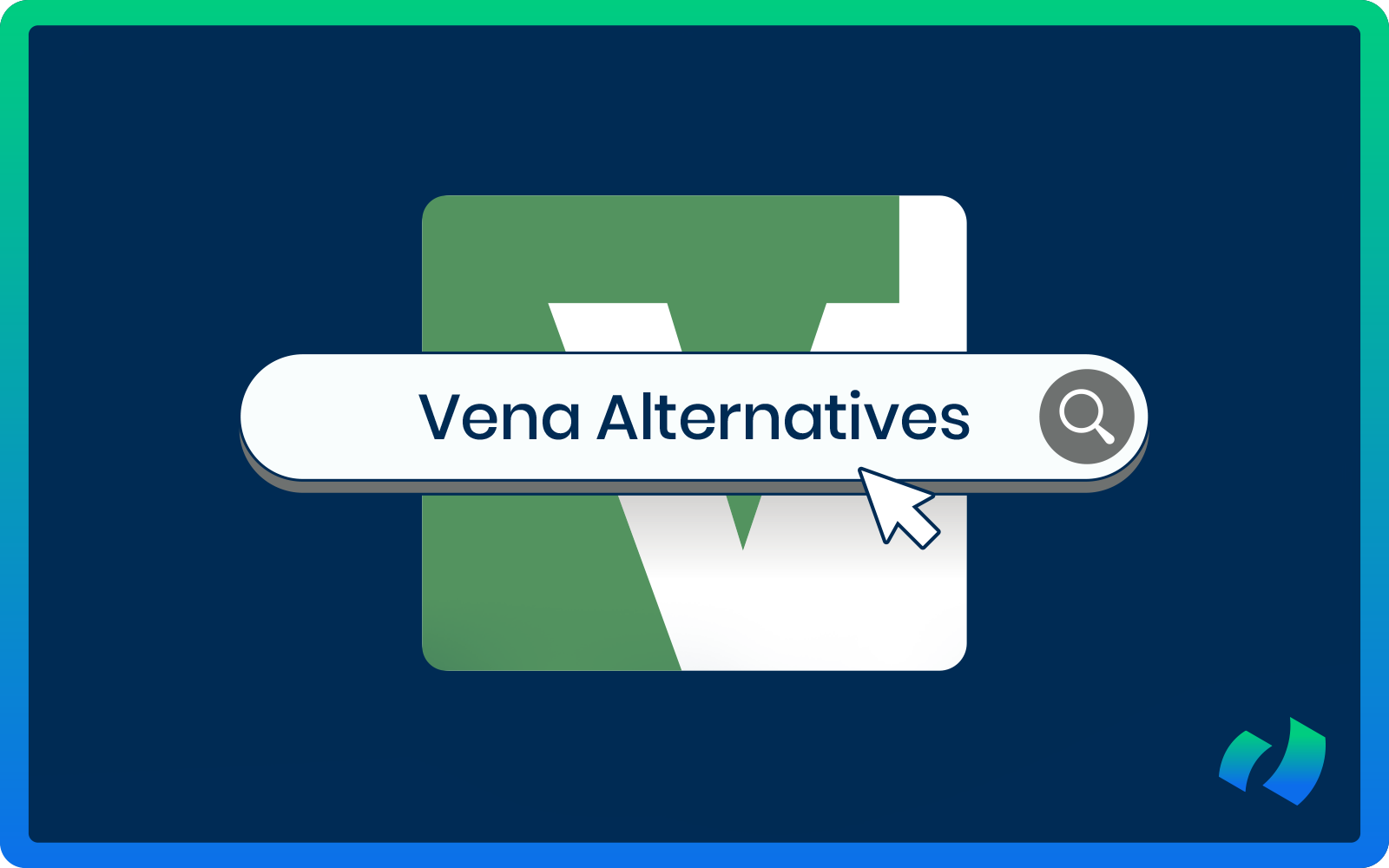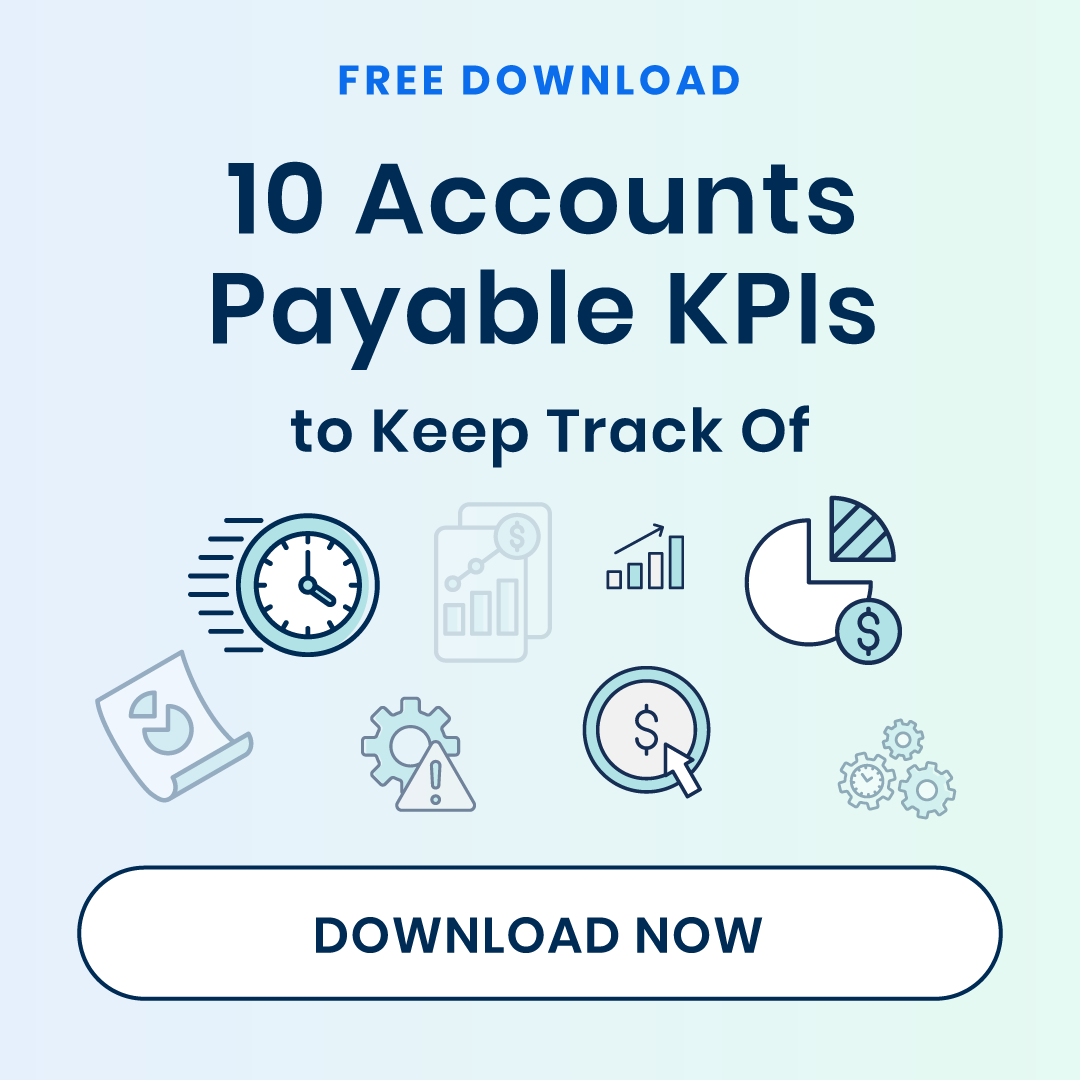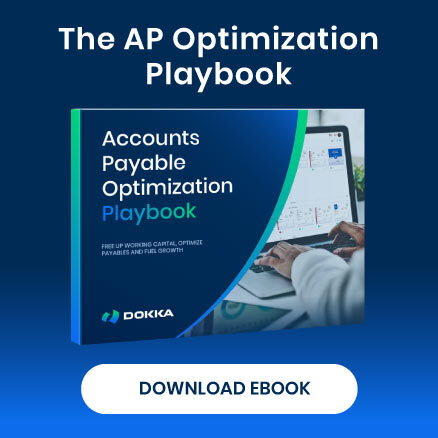Financial close automation is evolving fast, and finance teams are increasingly looking beyond traditional platforms for tools that offer more flexibility, better integrations, and a smoother user experience.
Vena Solutions remains a familiar name for organizations that rely on an Excel-friendly approach to budgeting, planning, and close management, but it’s not the only option, and in many situations, it may not be the best fit for today’s growing finance teams.
In 2025, a new generation of financial close solutions is delivering faster workflows, deeper automation, and more robust auditability. Whether you’re aiming to streamline reconciliations, reduce manual effort, or modernize your reporting process, exploring alternatives to Vena can help you find the platform that aligns with your operational needs and scalability goals.
Here is a look at the top Vena alternatives worth considering in 2025—comparing their features and ideal use cases to help you choose the right solution for your team.
8 Best Vena Alternatives for Financial Close Automation
- DOKKA
- FloQast
- Adra by Trintech
- Onestream
- Workiva
- BlackLine
- Planful
- HighRadius

1) DOKKA
Best For: Mid-sized to growing finance teams that want full close automation with AI-driven reconciliations, journal entries, and task management.
Overview:
DOKKA is designed to automate the entire close process. With AI-powered data extraction, it handles reconciliations, generates journal entries, and manages close tasks in a centralized, collaborative workspace.
The platform scales easily, integrating with major ERPs to keep close data synchronized and workflows smooth. Dashboards provide real-time insight into close progress, allowing teams to identify bottlenecks before they disrupt the month-end process.
Key Features:
- Automated GL reconciliations with variance detection
- AI-powered journal entry generation and approval workflows
- Close checklist and task management with a full audit trail
- Real-time dashboards for close status, exceptions, and task ownership
- Native integrations with ERPs for consolidated financial reporting
Why It’s a Good Alternative to Vena:
While Vena focuses on Excel-based planning and budgeting, DOKKA emphasizes automation of core close processes. It minimizes reliance on spreadsheets, accelerates reconciliations, and reduces the risk of manual errors (particularly valuable for teams looking to move beyond semi-manual close workflows).
Setup Process:
Onboarding with DOKKA is typically fast, with implementations often completed in weeks rather than months. DOKKA’s customer success team supports ERP integration, control setup, and close checklist design, helping finance teams transition seamlessly from manual to automated close processes.
G2 Customer Reviews:
Users frequently highlight DOKKA’s ease of use, the accuracy of its AI matching, and its ability to shorten close cycle times. Many report improved team efficiency and fewer reconciliation surprises thanks to robust exception tracking.
2) FloQast
Best For: Accounting teams that want a collaborative, checklist-driven close tool optimized for tasks and reconciliations.
Overview:
FloQast was designed by accountants for accountants. It provides a centralized workspace where close tasks are clearly defined and tracked, allowing teams to manage reconciliations, approvals, and documentation all in one place.
The platform integrates with Excel and accounting systems, making adoption easier for teams already familiar with these tools.
Key Features:
- Task list and close checklist management
- Reconciliation tracking and variance analysis
- Approvals and documentation workflow
- Integration with accounting systems and file storage
- Reporting on close progress and bottlenecks
Why It’s a Good Alternative to Vena:
Vena excels at planning and FP&A, but FloQast delivers more specialized functionality for accounting teams focused on month-end close. Its task-centric model helps standardize and streamline closing cycles, reducing the risk of missed items or delays.
Setup Process:
Implementation is relatively lightweight. FloQast guides teams in configuring the close workflow, defining task dependencies, and connecting to data sources. Onboarding is often completed within a few weeks.
G2 Customer Reviews:
Reviewers highlight FloQast’s transparency, ease of collaboration, and its ability to reduce manual close work. Many report shorter close times and improved team accountability.
3) Adra by Trintech
Best For: Mid-market organizations looking for robust reconciliation automation and task orchestration in their close process.
Overview:
Adra is part of Trintech’s close automation suite, providing reconciliation capabilities, task management, and a structured close workflow. It helps teams standardize balance sheet reconciliations and ensures a clear, auditable path to close each period.
With its modular design, Adra can scale to handle multiple entities and complex accounts.
Key Features:
- Automated balance sheet reconciliations
- Close task tracking and workflow orchestration
- Audit trail and variance reporting
- ERP integration for consistent financial data
- Collaboration tools with user-based access
Why It’s a Good Alternative to Vena:
Vena excels at FP&A and budgeting, whereas Adra focuses specifically on reconciliation and month-end close tasks. For teams where reconciliations are a bottleneck, Adra offers powerful tools to reduce manual effort and minimize risk.
Setup Process:
Adra onboarding involves setting up reconciliation templates, mapping accounts, and configuring task flows. The vendor provides support to ensure alignment with accounting policies and internal controls.
G2 Customer Reviews:
Users frequently report that Adra shortens reconciliation time, reduces reliance on spreadsheets, and boosts confidence in the month-end close. Its compliance and audit-readiness features are often highlighted as major benefits.
4) OneStream
Best For: Enterprises needing a unified CPM solution that handles consolidations, close, and planning.
Overview:
OneStream is a full-scale corporate performance management (CPM) platform that supports financial consolidation, financial close, planning, and reporting.
It is designed for complex, multi-entity organizations that require a single solution for both data aggregation and financial governance.
Key Features:
- Consolidation and multi-entity close
- Journal entry automation
- Task workflow and control orchestration
- Financial planning, budgeting, and forecasting
- Financial reporting and dashboards
Why It’s a Good Alternative to Vena:
Vena focuses on Excel-based financial planning, whereas OneStream combines close and consolidation in a unified environment. It works well for large organizations looking to move beyond Excel and standardize their close and planning functions on a single platform.
Setup Process:
OneStream deployment generally involves data mapping, consolidation model setup, and close process configuration. As an enterprise-grade solution, implementation can take several months, but the long-term benefits include high control and scalability.
G2 Customer Reviews:
Users appreciate OneStream’s deep feature set and its ability to replace legacy consolidation tools. Many highlight its capacity to handle multi-entity reporting and reduce reliance on multiple disparate systems.
5) Workiva
Best For: Highly regulated organizations or enterprises with a strong need for compliance, reporting, and audit control.
Overview:
Workiva is recognized for its connected reporting platform, which allows teams to pull data from multiple sources, link it, and produce consolidated financial statements or compliance reports.
It also supports task management and collaboration, making it a powerful tool for close teams focused on traceability and audit readiness.
Key Features:
- Connected reporting across financial and regulatory domains
- Close task tracking and version control
- Audit trails and full data lineage
- Collaboration tools for cross-team workflows
- Integrations with ERP and finance systems for data consolidation
Why It’s a Good Alternative to Vena:
Vena delivers strong FP&A functionality, but Workiva excels in reporting and compliance. Organizations that require detailed disclosures, audit documentation, or sustainability reporting will benefit from Workiva’s structured approach and traceability.
Setup Process:
Onboarding with Workiva involves template design, data integration, and workflow configuration. Their team assists in defining close processes, establishing controls, and training users across departments.
G2 Customer Reviews:
Users frequently highlight Workiva’s flexibility, audit-ready documentation, and cross-functional collaboration features. Its ability to unify data for reporting is consistently praised, especially in highly regulated environments.
6) BlackLine
Best For: Organizations needing robust reconciliation, intercompany, and journal process automation across many entities.
Overview:
BlackLine is a long-standing leader in close automation, supporting account reconciliations, task management, journal entry automation, and intercompany accounting. It is well-suited for larger teams managing complex, high-volume financial operations.
Key Features:
- Automated reconciliations and transaction matching
- Journal entry automation and policy enforcement
- Intercompany accounting automation
- Close task management and real-time visibility
- Audit trail and compliance reporting
Why It’s a Good Alternative to Vena:
While Vena is powerful for planning and budgeting, BlackLine is more specialized for operational close tasks. It offers stronger depth in reconciliation and accounting controls, which can significantly improve audit readiness and accuracy.
Setup Process:
BlackLine implementations typically include integration with your chart of accounts, defining reconciliation rules, and mapping intercompany flows. Its implementation team supports testing and validation to ensure a reliable and well-structured close.
G2 Customer Reviews:
Users frequently mention BlackLine’s ability to scale, its strong reconciliation capabilities, and the reduction in manual effort during month-end close. Many also highlight improvements in control, standardization, and overall process consistency.
7) Planful
Best For: Companies that want to unify their planning, consolidation, and close in a cloud-native platform.
Overview:
Planful offers financial consolidation, planning, forecasting, and reporting in one platform. It supports close processes with task automation and consolidation tools that help teams reduce cycle times and improve accuracy.
Key Features:
- Consolidation and close automation
- Budgeting and forecasting
- Workflow management and approval tracking
- Multi-entity reporting
- Real-time dashboards for financial performance
Why It’s a Good Alternative to Vena:
Both Vena and Planful offer planning and FP&A, although Planful provides a more centralized consolidation and close experience. Companies that want planning and close in a single platform—with less dependence on Excel—often view Planful as a strong contender.
Setup Process:
Implementation involves creating the consolidation model, designing close workflows, and building financial reporting templates. Planful’s onboarding team works to align the system with your existing financial calendar and established processes.
G2 Customer Reviews:
Users commend Planful for its ease of use, flexibility, and ability to bring planning and close workflows together. Many highlight improved forecast accuracy and more efficient consolidation.
8) HighRadius
Best For: Enterprise finance teams focused on AI-driven reconciliation and close automation at scale.
Overview:
HighRadius uses AI to power its “LiveCube” suite, which automates transaction matching, journal entries, reconciliation, and anomaly detection. The platform helps finance teams reduce manual close efforts and accelerate cycle times.
Key Features:
- AI-based reconciliation with high transaction match rates
- Automated journal entries supported by intelligent rule generation
- Anomaly detection and exception resolution handled through AI agents
- Close task orchestration and collaboration
Why It’s a Good Alternative to Vena:
Vena excels in planning and FP&A, yet HighRadius delivers next-generation reconciliation and close automation powered by AI. Teams that are scaling, managing complex data, or facing reconciliation bottlenecks gain deeper automation and predictive insights with HighRadius.
Setup Process:
HighRadius offers implementation services that include AI model configuration, ERP integration, and rule setup. Their team partners with customers to build and train “AI agents” designed to automate recurring close activities.
G2 Customer Reviews:
Users praise HighRadius’s automation capabilities, noting that it significantly reduces manual tasks and improves both the speed and reliability of their close. Many organizations also highlight high match rates and a lower risk of reconciliation errors.
Why DOKKA Is the Best Vena Alternative in 2025
When finance teams evaluate Vena, they often appreciate its planning capabilities and Excel-native model, but they may still struggle with manual close tasks and reconciliations. That’s where DOKKA shines.
With AI-powered reconciliation, journal automation, and real-time close task management, DOKKA removes much of the manual burden from month-end and enables faster, more accurate closes.
Unlike Vena, which remains heavily focused on FP&A, DOKKA gives equal weight to automation and the operational financial close. Its real-time dashboard, robust audit trail, and seamless ERP integration allow finance teams to trust their close data without spending hours reconciling or chasing tasks.
Finance leaders looking to modernize their month-end close process can schedule a demo to see how DOKKA supports a more efficient close with greater confidence.
Disclaimer:
All information presented about third-party products, pricing, or features is based on publicly available sources at the time of writing and is intended for general informational purposes only. DOKKA makes no representations or warranties regarding the accuracy, completeness, or currentness of competitor data. All trademarks and brand names are the property of their respective owners.
We encourage readers to verify details with the respective vendors before making any purchasing decisions.




